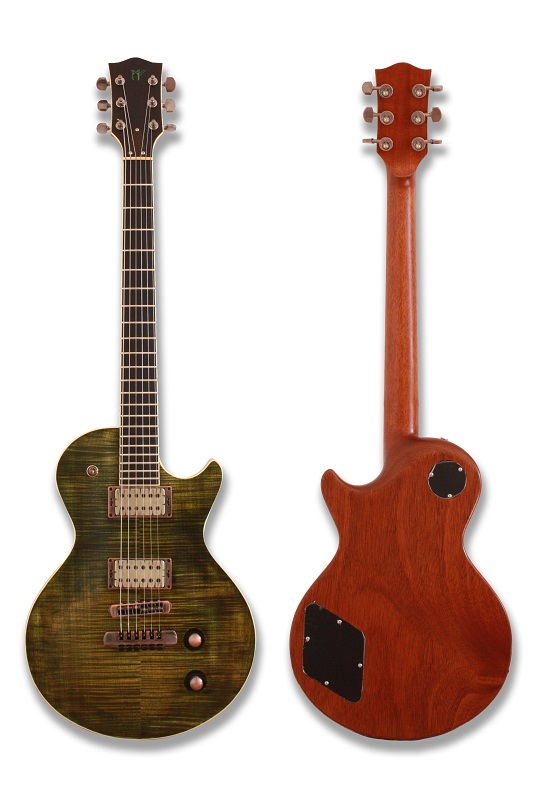Green Man
Spring 2014 – Summer 2016
SOLD
Model Name: Green Man
Color: Emerald Flame/Clear Shellac
Body Shape: Single-cut Carved Top
Body Material: Mahogany
Body Cap: Carved Flame Maple
Body Finish: Satin Shellac
Body Binding: Cream
Strap Buttons: Brass Dunlop Flush Fitting Straplok
Neck Type: Set Neck with All Access Joint
Neck Material: 3-Piece Mahogany (scarf joint)
Headstock Style: Classic 3×3
Neck Shape: Modern “C”
Neck Scale Length: 24.75”
Neck Binding: Cream
Headstock Binding: Cream
Nut: Brass
Nut Width: 44 mm
Fingerboard: Ebony
Fingerboard Radius: 14″
Number of Frets: 22
Fret Size: Jumbo (Dunlop 6100)
Fingerboard Inlays: N/A
Fingerboard Side Inlays: 3mm Brass Dots
Neck Pickup: Bare Knuckle Aftermath
Bridge Pickup: Bare Knuckle Aftermath
Controls:
- 1 x Master Volume, CTS 500K Coil-splitting potentiometer
- 1 x Master Tone, BKP 550K custom potentiometer
Pickup Switching: Classic 3-way Toggle
Hardware Finish: Vintage Copper
Bridge: Schaller STM
Tuning Machines: Schaller Da Vinci
Pickguard: N/A
Control Knobs: Knurled Brass Vintage Copper Finish
Switch Tips: Vintage Copper
Unique Features:
- Reconstituted Malachite ‘Matt Guest’ Runic Headstock Inlay
- Coil splitting function on push/pull Volume control
- Treble-bleed modification
The Green Man embodies the spirit of the forest and symbolises rebirth. This was my attempt to capture one of the most iconic and influential guitars of the modern era, Steve Vai’s Green Meanie. At the moment I am still building guitars to my own personal taste, so this project evolved into an interpretation of (in my opinion), the greatest electric guitar of all time, the ’59 Les Paul. The main aspect that differs from the original build of the ’59 is the neck-heel. Green Man features a rounded all-access-neck joint which gives very easy access to the upper register. The 3-piece mahogany neck has a full-feeling ‘C’ shape carve that really generates tone and sustain. Drawing from my personal preference, I have simplified the control layout to single Master and Tone for both pickups. Coil-splitting selection in the Master Volume allows instant single-coil Strat tones when required.
This has taken far longer than any of my other builds and feels like the best instrument I have worked on to date. I pondered over the headstock inlay design for many hours. It was originally intended to have an embodiment of the Green Man inlayed with Malachite, but limited resources meant that the result could have compromised the overall look and feel. In future builds I will revisit this design and utilise laser cutting technology to create the desired effect I have in my mind. As a result, the Green man guitar has a very reserved, simplistic finish which is reminiscent of the ’59 Les Paul.
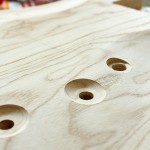 Green Man is going to be a classic single-cut carved top guitar which will feature Schaller brass control knobs. These are 18mm in diameter and around 15mm in height. Traditionally on Les Paul style carved-tops (from which Green Man is very much rooted), the neck control pots for volume and tone are placed on a heavy curve. Gibson don’t care too much about this, but Paul Reed Smith took some consideration for aesthetics and rightfully addressed the issue of the gradient creating a large gap under the control knob. PRS’ approach was to ‘scoop’ out the potentiometer hole so that the control knob actually sits in a little basin valley.
Green Man is going to be a classic single-cut carved top guitar which will feature Schaller brass control knobs. These are 18mm in diameter and around 15mm in height. Traditionally on Les Paul style carved-tops (from which Green Man is very much rooted), the neck control pots for volume and tone are placed on a heavy curve. Gibson don’t care too much about this, but Paul Reed Smith took some consideration for aesthetics and rightfully addressed the issue of the gradient creating a large gap under the control knob. PRS’ approach was to ‘scoop’ out the potentiometer hole so that the control knob actually sits in a little basin valley.
The gap underneath the control pot is not too extreme on the more traditional speed-knob or top-hat style controls, but Schaller knobs are quite narrow so they can tend to stick out like a sore-Glastonbury-Tor.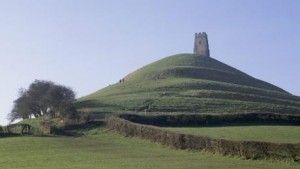
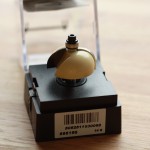 There are varying accounts of how to create this ‘dish’ on the internet, and I haven’t actually done it before, so I have researched quite a bit recently. Ben Crowe at Crimson Guitars ingeniously ground a flat drill bit to a rounded end to create the curved recess when drilling. But I have read accounts and watched Perry Ormsby of Ormsby Guitars use a Cove Router bit to create this. A bearing at the end of the bit is sized to match the hole drilled for the potentiometer, which allows accurate progression into the timber for the coving. This should be done on a pedestal drill stand obviously so it will be interesting to see how this works with my Black and Decker hand drill! There may be a good chance of some of the grain being torn out due to the relatively slow speed of rotation in comparison to a router machine. So I am preparing for some carving afterwards if it all goes pear-shaped.
There are varying accounts of how to create this ‘dish’ on the internet, and I haven’t actually done it before, so I have researched quite a bit recently. Ben Crowe at Crimson Guitars ingeniously ground a flat drill bit to a rounded end to create the curved recess when drilling. But I have read accounts and watched Perry Ormsby of Ormsby Guitars use a Cove Router bit to create this. A bearing at the end of the bit is sized to match the hole drilled for the potentiometer, which allows accurate progression into the timber for the coving. This should be done on a pedestal drill stand obviously so it will be interesting to see how this works with my Black and Decker hand drill! There may be a good chance of some of the grain being torn out due to the relatively slow speed of rotation in comparison to a router machine. So I am preparing for some carving afterwards if it all goes pear-shaped.
Once the controls have been coved I can start on staining the Maple-cap with several coats of black before sanding back to leave the grain darkened and a slight sun-burst effect. The top will then have a few coats of ‘purest-green’ to finish before being French polished.
Images taken through daily life, of inspirational images and designs I plan to use for inlay ideas across various projects.
 The primary delay of this project has been deciding on the headstock inlay. It has always been intended to be the head of the Pagan symbol Green Man, but I have laboured over the style and design for a long time.
The primary delay of this project has been deciding on the headstock inlay. It has always been intended to be the head of the Pagan symbol Green Man, but I have laboured over the style and design for a long time.
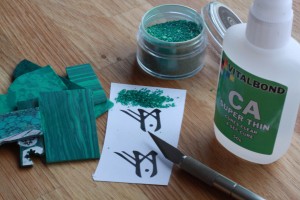 The inlay substrate will be some form of Green. I have not decided whether this will be cut from reconstituted rock Malachite (like the brand logo will be) or whether to experiment inlaying green rock granules. The method with the grains of rock would entail inlaying a channel into the timber, around 2-3 mm deep, then filling with the grains and back-filling with thin Cyanoacrylate. This is basically a very low viscosity Super Glue that is even ‘thinner’ than water, which will enable it to filter between the grains of rock before setting hard, ready to sand flat. I have not attempted this method before, and can only find vague reference of it’s use.
The inlay substrate will be some form of Green. I have not decided whether this will be cut from reconstituted rock Malachite (like the brand logo will be) or whether to experiment inlaying green rock granules. The method with the grains of rock would entail inlaying a channel into the timber, around 2-3 mm deep, then filling with the grains and back-filling with thin Cyanoacrylate. This is basically a very low viscosity Super Glue that is even ‘thinner’ than water, which will enable it to filter between the grains of rock before setting hard, ready to sand flat. I have not attempted this method before, and can only find vague reference of it’s use.
For the headstock design, I have trawled the internet for appropriate images and played around with minimalising the design ready for inlay. Here are some of the rough works that have not made the cut, to illustrate the basic work method. The finalised design will be much more ornate.
We have decided on an image to work from now at least. This will be edited into a silhouette form and then will go through a post-production stage to add shapes of flora around the edged of the hair and beard/moustache to keep the Pagan theme. Depending on how the resulting design looks, the eyes may be inset mother-of-pearl to highlight the piece.
All images will be inlaid into the black ebony headstock veneer.
Mjölnir is now available at Wunjo Guitars, Denmark Street, London.
Mjölnir
Autumn 2014 – Autumn 2015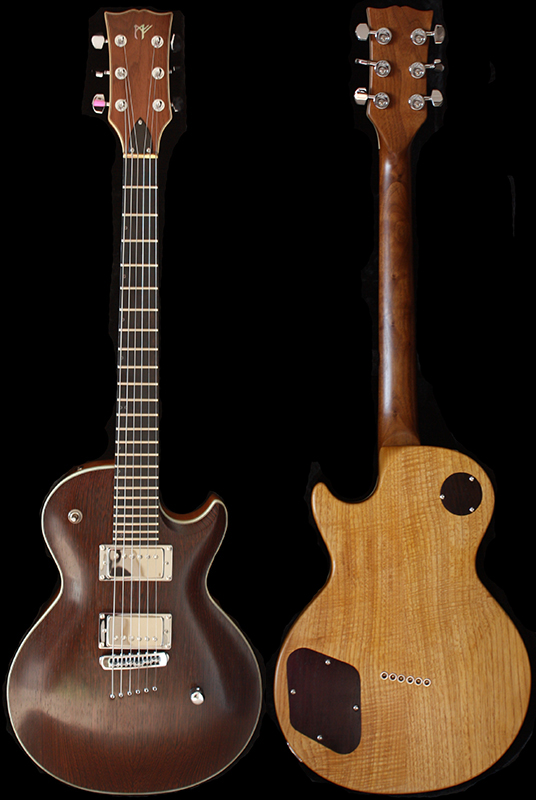
SOLD
Model Name: Mjölnir
Color: Clear Shellac
Body Shape: Single-cut Carved Top
Body Material: English Chestnut
Body Cap: Carved Wenge
Body Finish: Satin Shellac
Body Binding: Cream-Black-Cream
Strap Buttons: Chrome Dunlop Flush Fitting Straplok
Neck Type: Set Neck with All Access Joint
Neck Material: 1-Piece Walnut (scarf joint)
Headstock Style: Classic 3×3
Neck Shape: Uber-Wizard “C”
Neck Scale Length: 24.75”
Neck Binding: N/A
Headstock Binding: Cream-Black-Cream
Nut: Brass
Nut Width: 41 mm
Fingerboard: Ebony
Fingerboard Radius: Compound 12″-14″
Number of Frets: 24
Fret Size: Jumbo
Fingerboard Inlays: 3mm Steel Rings
Fingerboard Side Inlays: 2mm Black Dots
Neck Pickup: Bare Knuckle Miracle Man
Bridge Pickup: Bare Knuckle Miracle Man
Controls: Master volume
Pickup Switching: Classic 3-way Toggle
Hardware Finish: Chrome
Bridge: Schaller STM
Tuning Machines: Schaller Da Vinci
Pickguard: N/A
Control Knobs: Knurled Brass Chrome Finish
Switch Tips: Chrome
Unique Features:
- Black Tahiti Pearl ‘Matt Guest’ Runic Headstock Inlay
- Owen Jackson hand-made neck
- Crimson Guitars hand-made body
- Staggered ferrule, string-though carved-top body
Mjölnir was a project to achieve a guitar that would require no additional adornment other than it’s own figured tone wood. Imparting the spirit of a mythical hammer, I chose a almost entirely chromed finish of hardware to give a feel of steel. I wanted to create a soulful carved-top guitar with maximum tone and sustain; so a string-through body design was an obvious choice.
Originally planned as a homage to one of my favourite classic Metal bands, Manowar, this project was born as I listened to ‘Thor (The Powerhead’ at work. Thor’s hammer Mjölnir was an obvious symbol to base such a guitar on. Initially I had designs to inlay the Sign of the Hammer symbol across the fretboard in Mother of Pearl. However after offering up the designs to the fretboard, there was no acceptable area to apply the inlay without obscuring the image too much or damaging the aesthetics of balance. Inlaying the design on the body itself would have taken too much away from the beautifully figured Wenge top.
Therefore the fretboard was left totally blank. Visually this is beautiful for such a quality piece of Ebony, but this needed to be a work-horse of a guitar. Personal preference is paramount, and in my opinion some indication is required around the higher register of the neck. I decided to add steel-ring inlays, offset to the low E-string so that they were easily visible to the player, but as they are aligned closely with the ‘E’ and ‘A’ strings and are not full dots, to the bystander they are almost imperceptible.
The neck is a one-piece English Walnut, commissioned by Owen Jackson. This was one of two necks I sourced for the Thorn Project, so this has a very petite 41mm nut and Wizard profile. The guys at Crimson Guitars expertly took this bolt-on style neck and adapted it for a set-neck construction in Mjölnir. The neck-joint is a very comfortable all-access type, allowing fretting up around the second octave very natural.
I have yet to find superior pickups available in comparison to Bare Knuckle‘s. This time I chose a Miracle Man humbucker set, aiming for a slightly more trebly tone for achieving the ferocity of pinched harmonics. As will be apparent from my existing portfolio, I am not a fan of tone pots. I believe you can achieve all the tonal variations from the placement of the available pickups and choice of amplifier without masking the pure sound of the guitar/pickup combination. I opted for a single master volume pot in this case to limit the number of controls that would hide the beautiful Wenge grain.
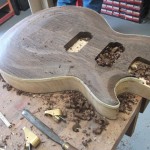 I had this project commissioned by Crimson Guitars in Dorset. As this will be a clear shellac finish ultimately, the importance of quality figured timber was paramount. The carved dark Wenge top will be in stark contrast to the lighter, golden English Chestnut body once the French Polishing is completed. Featuring Bareknuckle Miracle Man calibrated humbuckers at the heart of the body, all other hardware will be in matching Chrome finish.
I had this project commissioned by Crimson Guitars in Dorset. As this will be a clear shellac finish ultimately, the importance of quality figured timber was paramount. The carved dark Wenge top will be in stark contrast to the lighter, golden English Chestnut body once the French Polishing is completed. Featuring Bareknuckle Miracle Man calibrated humbuckers at the heart of the body, all other hardware will be in matching Chrome finish.
See Mjölnir being carved in the Crimson Guitars workshop
Thorn Project
Spring 2012 – 2015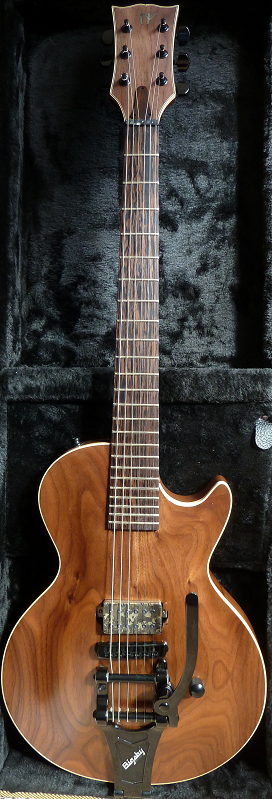
PERSONAL COLLECTION
Model Name: Thorn
Color: Natural Walnut
Body Material: Walnut
Body Shape: Les Paul
Body Finish: Tung Oil
Neck Material: Walnut
Neck Style: 3×3
Neck Shape: Uber Wizard “C”
Scale Length: 24.75”
Fingerboard: Wenge
Fingerboard Radius: Compound 12″-14″
Number of Frets: 24
Fret Size: Jumbo
Nut: Granite Corian
Nut Width: 41 mm
Side Inlays: White
Pickup Configuration: Humbucker Bridge
Bridge Pickup: Bare Knuckle Warpig
Neck Pickup: N/A
Controls: Master volume, Coil-split
Pickup Switching: N/A
Bridge: Schaller STM Black/Bigsby B700
Hardware Finish: Black
Tuning Machines: Schaller Da Vinci
Pickguard: N/A
Control Knobs: Schaller Black Knurled Brass
Switch Tips: N/A
Unique Features:
- Crimson Guitars hand-made neck
- Owen Jackson hand-made body
- Treble-bleed wiring modification
- Humbucker coil-split switching volume
- Chambered Walnut body

